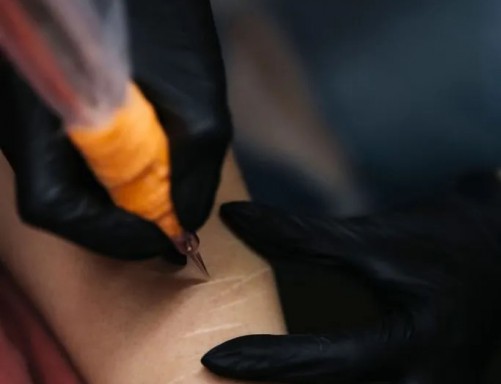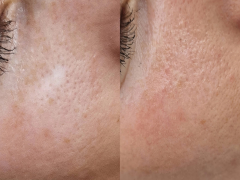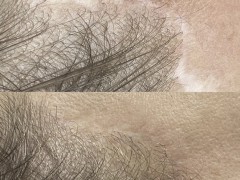Scar camouflage tattooing is a specialized technique designed to blend scars with the surrounding skin, creating a smoother, more even texture and disguising imperfections. Using skin-toned pigments, this treatment effectively reduces the visibility of scars, restoring your skin’s natural appearance and enhancing your confidence.
As a certified artist trained in NUE Conceal, I specialize in advanced scar camouflage techniques, customizing each treatment to match your unique skin tone and needs. To ensure the perfect pigment match, I use a state-of-the-art skin tone reader, a unique tool that helps me blend pigments precisely to your skin tone for the most natural and seamless results.
Think of it as a semi-permanent solution to scars, providing you with a flawless finish that lasts. After the healing process, scars are significantly less noticeable, giving you the confidence to wear whatever you love—whether it’s exposed skin or your favorite outfits.
Duration: 2-3 hours (depending on the treatment area)
Pricing: Varies depending on the size and complexity of the scar

* Reduces the Appearance of Scars – Helps scars blend in with the surrounding skin, making them less visible.
* Boosts Confidence – Many clients feel more comfortable in their skin after treatment.
* Long-Lasting Results – Unlike makeup, which washes off, scar camouflage can last for years.
* Safe & Non-Invasive – A great alternative to laser treatments or surgical scar revision.
* Custom Color Matching – Pigments are tailored to each client’s skin tone for a seamless blend.
* Improves Skin Texture – Some techniques stimulate collagen production, which can enhance skin smoothness.
What Scars Does Scar Camouflage Work Best On?
Fully Healed Scars – Must be at least 12–18 months old and fully healed.
Lighter Than Surrounding Skin – Works best on hypopigmented (white or lighter) scars.
Flat or Slightly Raised Scars – Ideal for flat, smooth scars or slightly raised ones.
Surgical Scars – Effective on C-section, tummy tuck, facelift, mastectomy, and other surgical scars.
Burn Scars – Can be camouflaged if they are smooth and fully healed.
Injury Scars – Including scars from accidents, cuts, or lacerations.
Breast implant scars/ tummy tuck/ liposuction, c sections), self inflicted or accidental.
1.Consultation & Patch Test: The process begins with a consultation to assess the scar type, age, and color. A patch test may be done to ensure proper pigment selection and healing.
2. Color Matching: We have revolutionary skin tone device that reads a person’s skin tone.
3. Scar Preparation: If necessary, skin treatments (such as microneedling) may be recommended beforehand to smooth and prep the area.
4. Pigment Application: A tattooing machine with a fine needle deposits pigments into the scar. Layering techniques are used to mimic the skin’s natural color variations.
5. Healing Process: Initial healing takes about 7–14 days, but full results develop over 4–6 weeks. Some clients may need multiple sessions for the best outcome.
6. Touch-Ups & Maintenance: A follow-up appointment ensures the pigment has healed properly and allows for adjustments if needed. Results can last several years but may fade over time, requiring occasional touch-ups
1.Consultation & Patch Test: The process begins with a consultation to assess the scar type, age, and color. A patch test may be done to ensure proper pigment selection and healing.
2. Color Matching: We have revolutionary skin tone device that reads a person’s skin tone.
3. Scar Preparation: If necessary, skin treatments (such as microneedling) may be recommended beforehand to smooth and prep the area.
4. Pigment Application: A tattooing machine with a fine needle deposits pigments into the scar. Layering techniques are used to mimic the skin’s natural color variations.
5. Healing Process: Initial healing takes about 7–14 days, but full results develop over 4–6 weeks. Some clients may need multiple sessions for the best outcome.
6. Touch-Ups & Maintenance: A follow-up appointment ensures the pigment has healed properly and allows for adjustments if needed. Results can last several years but may fade over time, requiring occasional touch-ups
My Dearest Client,
Thank you so much for entrusting your skin with me. Now that we have completed your first session, what happens next entirely depends on your aftercare.
To prevent any infection, please take your time to read and follow this aftercare.
DURING THE FIRST 48 HOURS:
- Wash the area at least twice a day with antiseptic soap.
- Dry the area with toilet paper or a fresh, clean towel.
- Apply ointment (Aquaphor) 2x per day for 8 weeks (or until your next treatment).
- Protect the treated area by always wearing clean, loose shirt/jogging pants.
ON THE SECOND DAY AND FOR THE NEXT 7 DAYS:
- Every 4 to 6 hours, apply the aftercare ointment to the treated area, stimulating the healing of camouflage scars. Ensure that your hands are clean and sanitized before applying to the ointment to prevent infection.
DURING THE FIRST 7 DAYS, PLEASE AVOID:
- Scratching
- Removing scabs
- Taking immersion baths (swimming pool, beach, bathtub)
- Going to saunas
- Allowing excessive sweating (workout)
- Exposing the area to excessive heat and suffocation (tight clothes)








